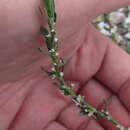ar
الأسماء في صفحات التنقل


Polygonum erectum (lat. Polygonum erectum) - qırxbuğumkimilər fəsiləsinin qırxbuğum cinsinə aid bitki növü.
Polygonum erectum (lat. Polygonum erectum) - qırxbuğumkimilər fəsiləsinin qırxbuğum cinsinə aid bitki növü.
Polygonum erectum, commonly called erect knotweed, is a North American species of herbaceous plant in the buckwheat family (Polygonaceae). It is found primarily in the northeastern and north-central parts of the United States, but with scattered populations in other parts of the US and also in Canada.[1]
Its natural habitat is in bottomland forests and riparian areas. It is tolerant of ecological degradation, and can also be found in disturbed open areas such as pastures and lawns.[2][3]
It was once cultivated for food by Native Americans as part of the group of crops known as the Eastern Agricultural Complex.
Polygonum erectum is an erect annual growing 10–75 cm (4–29.5 in) tall with many to few, non-wiry branches. The leaves have distinct veins and entire edges or have jagged cut edges. The pedicels are shorter or equal the length of the calyx and typically longer than the ocreae. The closed flowers have a calyx that is typically 3 mm (0.12 in) long, green in color and 5-lobed. Flowers in clusters of 1 to 5 in cymes that are produced in the axils of most leaves. The calyx segments are unequal with the outer lobes longer and not keeled and the inner ones narrowly keeled. The tepals are greenish, with yellowish tinting or sometimes with whitish tints. The seeds are produced in fruits called achenes that can be of two different types; one type is dark brown with a shiny surface and is broadly egg-shaped, typically about 2.5 mm (0.098 in) long. The other achene type is dull brown, exsert and egg-shaped, and 3–3.5 mm (0.12–0.14 in) long. Late season fruiting is uncommon and if produced the achenes are 4 to 5 mm (0.16 to 0.20 in) long.[4][5]
Polygonum erectum is considered to be globally secure.[6] However, it is uncommon throughout much of its range, and population have declined dramatically in some regions.[2][7] It is listed as endangered in New Hampshire and New York.[8]
Polygonum erectum, commonly called erect knotweed, is a North American species of herbaceous plant in the buckwheat family (Polygonaceae). It is found primarily in the northeastern and north-central parts of the United States, but with scattered populations in other parts of the US and also in Canada.
Its natural habitat is in bottomland forests and riparian areas. It is tolerant of ecological degradation, and can also be found in disturbed open areas such as pastures and lawns.
It was once cultivated for food by Native Americans as part of the group of crops known as the Eastern Agricultural Complex.
Polygonum erectum
La renouée dressée est une espèce de plantes herbacées de la famille des Polygonaceae qu'on trouve en Amérique du Nord[1],[2].
Son habitat naturel se trouve dans les forêts alluviales et ripisylves. Tolérant la dégradation écologique, on peut aussi la trouver dans les espaces ouverts comme les prés ou les pâtures[3],[4].
Elle fut longtemps utilisée par les Amérindiens dans le cadre de l’Eastern agricultural complex (l'un des premiers pôles où a été pratiquée l'agriculture), avant l'introduction du maïs, et on a retrouvé des preuves de culture de la renouée dressée sur plusieurs sites archéologiques[5],[6].
Elle mesure de 10 à 75 cm de haut, et peut avoir beaucoup ou peu de branches. Les feuilles ont des nervures distinctes et des bords soit entiers, soit en dent-de-scie. Le pédicelle est plus petit ou de taille comparable au calice et généralement plus long que l'ochréa. Les fleurs fermées ont un calice qui mesure généralement 3 mm de long, de couleur verte et à 5 sépales. Les fleurs sont au nombre de 1 à 5 dans des grappes en cyme près de la plupart des feuilles. Les segments du calice sont inégaux, les lobes extérieurs étant plus longs et non carénés, tandis que les lobes intérieurs sont étroitement carénés. Les tépales sont verdâtres, avec une teinte jaunâtre ou parfois avec des teintes blanchâtres. Les graines sont produites dans des fruits akènes qui peuvent être de deux types différents ; un type est brun foncé avec une surface brillante et est largement ovoïde, généralement d'environ 2,5 mm de long. L'autre type est d'un brun terne, exsert et ovoïde, et mesure de 3 à 3,5 mm de long. La fructification en fin de saison est rare et si elle a lieu, les akènes mesurent 4 à 5 mm de long[7].
Polygonum erectum
La renouée dressée est une espèce de plantes herbacées de la famille des Polygonaceae qu'on trouve en Amérique du Nord,.
Polygonum erectum (binomen a Linnaeo anno 1753 statutum) est species plantarum Polygonacearum olim in America septentrionali culta. Pars habetur complexus agrarii orientalis.
Polygonum erectum (binomen a Linnaeo anno 1753 statutum) est species plantarum Polygonacearum olim in America septentrionali culta. Pars habetur complexus agrarii orientalis.